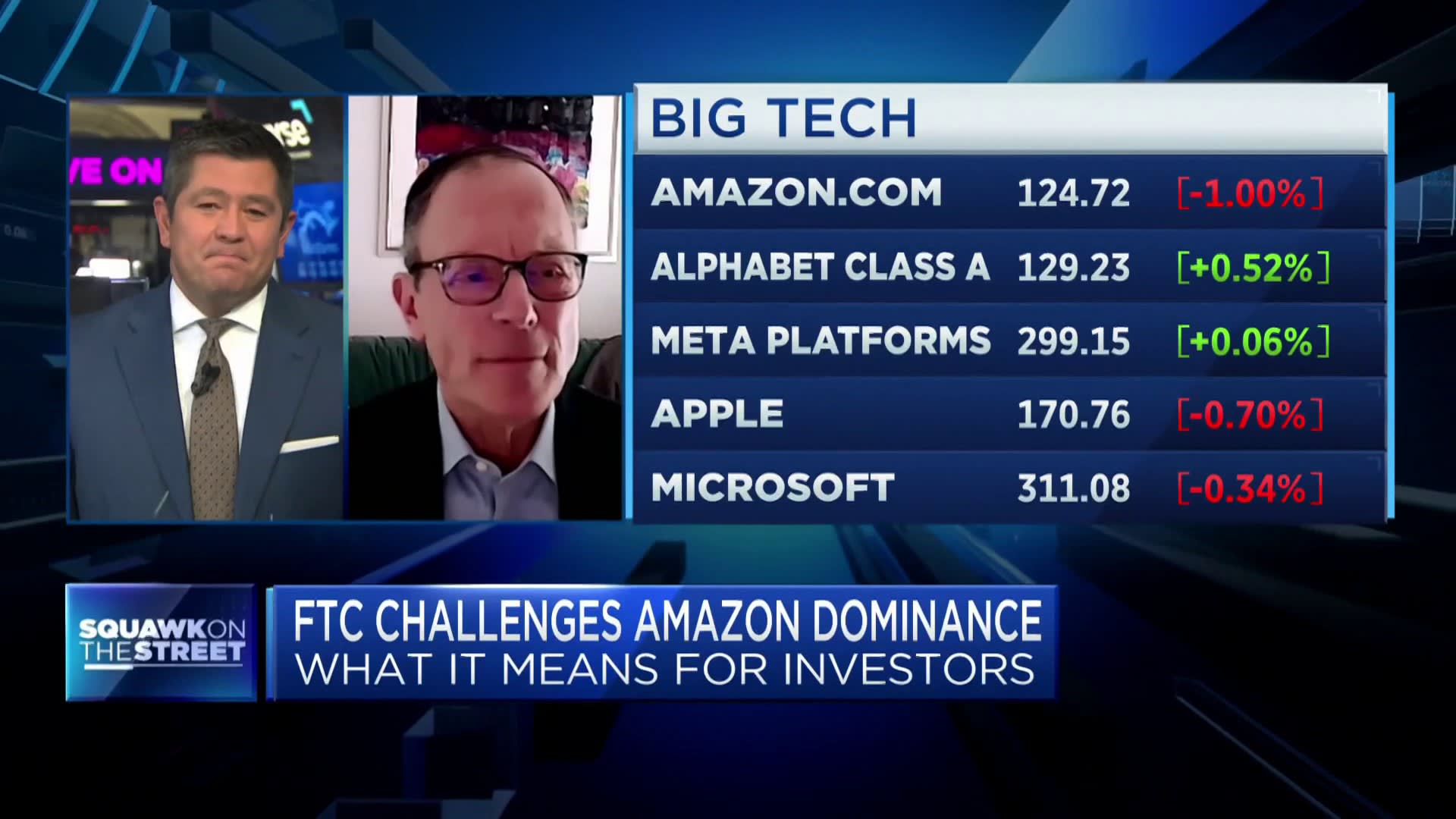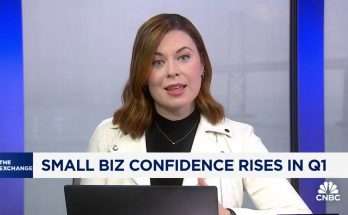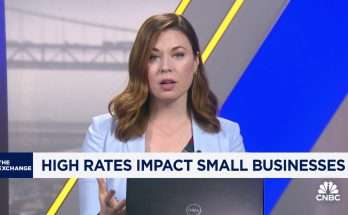Products in a loading bay at an Amazon fulfillment center on Prime Day in Melville, New York, US, on Tuesday, July 11, 2023. Amazon.com Inc.’s annual Prime Day shows that e-commerce isn’t the driver it once was for the stock, as investor focus shifts to the company’s faster-growing and profitable cloud-computing unit. Photographer: Johnny Milano/Bloomberg via Getty Images
Bloomberg | Bloomberg | Getty Images
Amazon may be the epitome of big business, but more than 60% of the behemoth’s sales last year came from small- and medium-sized businesses. Small businesses rely on Amazon for its reach and breadth, while Amazon needs independent sellers to fill its site with products.
But the relationship can be uneasy. Sellers have complained about rising costs to sell on the site. The Federal Trade Commission antitrust lawsuit against Amazon, meanwhile, accusing the e-commerce giant of wielding its “monopoly power” to raise prices, stifle competition and leave shoppers with worse service. The lawsuit also accuses Amazon of forcing sellers to pay expensive fulfillment and advertising fees, with little choice but to rely on the e-commerce giant to stay in business.
“It’s the same playbook again and again,” said Scott Lieberman, an e-commerce consultant and founder of TouchdownMoney.com. Companies are “super friendly” to small businesses in the beginning to attract traffic. Then the rules change, and it becomes increasingly expensive for businesses to operate on the platform, he said.
Nevertheless, many small businesses rely on Amazon as a vital part of an e-commerce strategy. While among sellers recently interviewed by CNBC there was a feeling that the FTC case is “long overdue,” they don’t necessarily agree with all of the FTC allegations. And they aren’t sure much will change in the relationship.
“I think that the power that Amazon wields over sellers is considerable and absolutely worth looking into,” Scott Needham, who both sells on Amazon and provides tools to other sellers, told CNBC. “But I’m not sure if this would actually change that.”
Amazon‘s success has inspired others to follow suit, allowing independent sellers to reach consumers on more e-commerce platforms. Consumers shopped on big marketplaces such as Amazon and Walmart 30% more in 2023 compared with 2022, according to a recent survey by product marketing specialist 1Worldsync. Globally, sales from third-party online marketplaces are expected to be the fastest-growing retail channel over the next five years, making up 60% of all global e-commerce sales growth, according to Edge by Ascential, a market research and consulting firm.
This shift to third-party sellers — like online bazaars — is changing the retail landscape, creating more work for small businesses. When selling to first-party sellers, small businesses may deal with a buyer, ship in bulk, then get paid depending on how well the product sells. Businesses often have little control over how the product is placed or marketed. But to do well on third-party marketplaces, companies need to be more hands-on with pricing, placement, advertising and more. It’s not enough just to be in the marketplace.
With significant costs and complexity to succeed on Amazon and in wider world of e-commerce, here are keys that experts say small business owners need to know.
You compete against yourself on pricing
Amazon’s “anti-discounting strategy” tracks prices online and punishes sellers who sell their product cheaper elsewhere by removing their listing from the coveted “click to buy” box. The FTC contends that Amazon’s “anti-discounting tactics” prevent rivals from growing. E-commerce consultants say the pricing is tricky and that pressure to keep prices lowest on Amazon makes it challenging for small businesses to balance relationships with other e-commerce platforms.
“It’s sort of forcing you to be the cheapest. Whereas you may have different economics on every platform,” said Phil Masiello, founder and CEO of CrunchGrowth Revenue Acceleration Agency,
Selling on Amazon comes with significant costs that add up to almost half the listing price — 15% to list, another 10% to 15% for Amazon’s fulfillment services, and 15% to advertise. But competing platforms, whether a seller’s own website, Target, Walmart or others come with their own cost structure challenges. Companies often don’t have control over how their products are priced on other platforms. Companies that sell direct to the consumer must pay to store inventory and pack and ship goods. They must also pay advertising costs. All these factors affect wholesale and retail pricing.
More and more, small businesses that sell on multiple platforms “are competing with themselves,” said Randy Mercer, chief product officer at 1WorldSync, which helps sellers market their products. “That’s the weird thing that comes into play for smaller manufacturers,” he said. The pricing pressure from Amazon and other third-party marketplaces can be hard to withstand. Mercer said he’s seeing more small businesses use analytic platforms to track where their products are sold and at what price.

An Amazon spokesman said the company’s approach is to grow the success of our third-party selling partners over the long-term, which in turn increases selection for customers. He said third-party sellers set their own prices, and Amazon offers optional tools to support them in offering low, competitive prices. The vast majority of millions of featured offers are priced as well or better than at competing retailers, and if an “Add to Cart” button is removed when Amazon learns that a competitor sells the same product for less, it remains available for purchase.
Costs are significant, but big profit margins are possible
As Amazon has grown, its costs to sellers have also increased. The FTC lawsuit focuses on pressure on sellers to keep prices low while also paying for fulfillment and advertising fees. Consultants say the costs may be high, but the cost structure is not unlike that of traditional bricks-and-mortar retail. The fees may be significant, but so is the reach. For those who create and sell a proprietary or branded product, “you can reach a lot of people and the amount of money that you’d have to spend to reach that amount of people or drive them to your own website would be significant,” said Joe Camberato, CEO and founder of National Business Capital, a fintech marketplace.
Many businesses have been surprised by the work it takes to succeed on third-party marketplaces like Amazon. “Many brands and startups, even established brands, don’t understand the economics of their product,” Masiello said. Many clients hope to find a way to negotiate the listing and fulfillment fees, but the only way to lower prices, he said, is through tighter supply chain management. Companies need to keep product costs at 30% or less, and including FBA costs, advertising and overhead, most successful sellers on Amazon should aim for a profit margin of 10%, he said.
Amazon contends that sellers who choose to purchase optional services from Amazon do so because they provide more value than they can get elsewhere. Sellers who choose to purchase Amazon Ads, for example, do so because they can successfully reach customers are ready to buy, the Amazon spokesman said. Fulfilment by Amazon, he said, remains an average of 70% less expensive than two-day shipping methods offered by other major third-party logistics providers.
The time for amateurs on Amazon is over
There was a time when amateurs could list and sell products on Amazon and make money, but that time is in the past. Amazon has now also grown to be one of the internet’s largest advertising platforms, behind Google and Meta, which owns Facebook and Instagram. Getting a listing to show up on Amazon takes expertise, much like search engine optimization on Google.
“You have to figure out the Amazon way — their algorithm and maybe even pay to sponsor your product and get it to the top of that first page” as one of the first few product listings, Camberato said. “I don’t think you’re going to win by trying to fight Amazon and you’re not going to win by trying to fight Google. You really have to figure out these algorithms and how to manage a budget around it,” he said.



